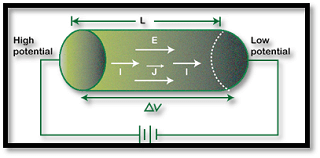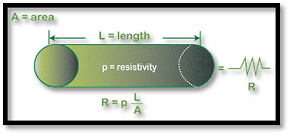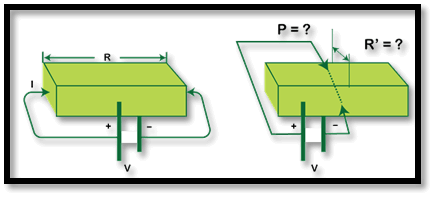Difference between Resistance and ResistivityThe concept of resistance and resistivity is among the most fundamental and crucial components of the idea of current and electricity. The main distinction between a material's resistance and its resistivity is that a material's resistance obstructs the flow of electrons. Still, a material's resistivity is a feature that precisely describes a material's resistance. 
ResistanceResistance is characteristic of a substance that prevents a current from flowing freely. Charged particles in a conductor moving in a particular direction when a voltage is applied to it. These traveling electrons cause atoms or molecules to collide, creating heat in the process. These atoms or molecules prevent free electrons from moving freely inside a substance. The electrical resistance of a certain thing is the measurement of that object's resistance to current flow. Its inverse quantity is electrical conductance, which gauges how freely electric current moves. Conceptually, electrical resistance and mechanical friction are comparable. Ohm, the SI unit for electrical resistance, are used to quantify electrical resistance. The material a thing is built of has a significant role in determining how resistant it is. Electrical insulators, such as rubber, tend to have extremely high resistance & poor conductance, whereas electrical conductors, such as metals, tend to have comparatively low resistance and good conductivity. This relationship can be measured in terms of conductivity or resistivity. The size and form of an object also play a significant role in these characteristics because resistance & conductance are extensive instead of intensive properties. As an illustration, a wire's resistance rises with length & thinness and falls with length and thickness. All objects, excluding superconductors, have zero resistance toward an electrical current. It is formulated as follows: R = ρ x l / a Where, 'l' is the conductor's length 'a' is the conductor's cross-section area 'ρ' is the resistivity of the material. 'R' is the resistance Resistance-affecting factorsThe following things affect the wire's resistance.
ResistivitySpecific resistance is another name for resistivity. The resistivity measures a material's resistance with defined dimensions, such as a cross-sectional area of 1 square meter and a length of 1 meter. 
Electrical resistivity, also known as specific resistance value or volume resistivity, is a key property of a substance that gauges how effectively it resists electric current flow. A material has poor resistance when it is easily permeable to electric current. The Greek letter is often used to signify resistivity (rho). The ohm-meter (m), which measures electrical resistance, is a SI unit. Consider a solid cube of material measuring 1 m3 that has sheet connections on its two opposite faces. If the resistance between such contacts equals 1, the material has a resistivity of 1 m. The temperature of a substance and its resistivity have a clear relation. The resistance provided between the opposing two phases of the one-meter cube is what the term "resistivity" means for a cube with a one-meter side. It is formulated as follows: ρ = R x a / l Where 'l' is the conductor's length 'a' is the conductor's side view area 'R' is the material's resistance 
Difference between Resistance and ResistivityKey Distinctions between Resistivity and Resistance are as follows:
Resistance and resistivity both indicate how challenging it is to induce an electrical current through a material; however, resistivity differs from resistance in that it is an intrinsic feature. This means that regardless of shape or size, all pure copper wires-those whose crystalline structure has not been altered-have the same resistivity; nonetheless, a prolonged, thin copper wire has a significantly higher resistance than a short, thick copper wire.
Next TopicDifference between
|
 For Videos Join Our Youtube Channel: Join Now
For Videos Join Our Youtube Channel: Join Now
Feedback
- Send your Feedback to [email protected]
Help Others, Please Share










